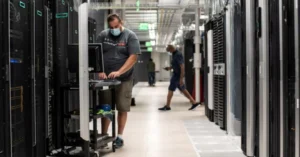VNC is one of the most common methods to access servers remotely by multiple users simultaneously. VNC is usually configured as a systems service that is always on, serving a GUI session for a single or multiple users simultaneously. There is no limit on the number of VNC sessions in a Linux-based server, but constraints are based on available server resources that can be used effectively.
Simultaneous VNC sessions are limited by three primary resources in a server: CPU, RAM, and bandwidth. In a VNC user session, software-based rendering renders the Graphical User Interface (GUI) to the video frame buffer used for remote connectivity.
As such, a VNC session typically consumes high CPU resources than a local console. Similar resources utilization affects the RAM and bandwidth, as the VNC session uses system RAM for Its video frame buffer instead of video RAM.
VNC sessions constrain network bandwidth, as it uses video compression techniques for desktop display, which is less efficient. It should be noted that running videos or graphics video editors on a VNC session will increase resource utilization.
Generally, you can allocate 1 CPU core, 4GB RAM, and 10Mbps network bandwidth for each VNC session. It is recommended that for 8 VNC users, an 8-Core CPU, 32GB RAM, and 300Mbbps network connection is required.
Some mitigation strategies are given below if you have limited hardware resources on a VNC server and serve multiple VNC users.
- Instead of using GNOME sessions, use minimal X sessions to reduce VNC server load.
- Reduce screen geometry with geometry options such as geometry=800×600.
- Enable QoS (Quality of Service) to prioritize VNC over regular user sessions.
- Limit VNC sessions to single tasks instead of running multiple processes simultaneously.




Leave a Reply
You must be logged in to post a comment.